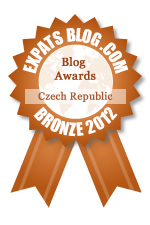By Ricky, on March 13th, 2014 The tower of the Church of St. Kunhuta, Nové Mesto na Morave © Ricky Yates
Following worship in Brno last Sunday evening, I stayed overnight with a family who are members of the congregation, in order on the next day, to meet up and have lunch with a Czech-British couple living near Olomouc. After a most enjoyable lunch, I headed back across the Vysocina (Highlands), in order to meet up with a Czech teacher of English, living and working in Žd’ár nad Sázavou, who has been using part of the text of this blog, as teaching material with his students.
Being ahead of myself time-wise for my meeting with the Czech teacher on Monday evening, I stopped off about ten kilometres short of Žd’ár nad Sázavou, to explore the small town of Nové Mesto na Morave. The town’s name literally means ‘New Town in Moravia’. But like many . . . → Read More: The Church of St. Kunhuta, Nové Mesto na Morave
By Ricky, on October 26th, 2013
Our lunchtime view across Masarykovo námestí, Pelhrimov © Ricky Yates
As I mentioned in my previous post about the Church of St Bartholomew, here is the promised further illustrated post about the town of Pelhrimov itself, which we visited earlier this week on Tuesday 22nd October 2013.
Pelhrimov lies a short distance off the D1, the Prague-Brno motorway, just over one hundred kilometres south east of Prague. It should only take about an hour and a quarter to drive there but took us nearer one hour and forty minutes, because of traffic delays getting across and out of Prague. Like many Czech towns, there is industry and Communist era paneláks around the outskirts, but there is also a historic, well-preserved and restored centre, with many attractive buildings. Having found a suitable parking place for the car, we set out for the main square, Masarykovo . . . → Read More: Pelhrimov
By Ricky, on October 22nd, 2013
Sgraffiti decoration on the exterior walls of the Church of St Bartholomew, Pelhrimov, with the fresco decorated alcoves below. © Ricky Yates
For a number of reasons, I took my day-off this week today, rather than yesterday. Taking advantage of some wonderful Indian summer weather, Sybille and I drove just over one hundred kilometres south-east of Prague and explored the interesting historic town of Pelhrimov. A much longer and more detailed post about the town will follow shortly. But tonight, I just wanted to post about one fascinating discovery that we made today, whilst exploring this delightful town.
At one corner of Masarykovo námestí, the main square in the centre of Pelhrimov, is the Church of St Bartholomew – kostel sv Bartolomej. The Church dates from the late thirteenth/early fourteenth century and much of its exterior walls are decorated with sgraffiti as can be seen . . . → Read More: The Church of St Bartholomew, Pelhrimov
By Ricky, on October 26th, 2011
Tábor with the spire of the Church of the Transfiguration of our Lord © Ricky Yates
As part of my two weeks of annual leave following my return from the Eastern Archdeaconry Synod in Bucharest, Sybille and I spent a long weekend at the beginning of October, staying in Tábor, exploring this fascinating historical town and parts of the surrounding area of South Bohemia. During the whole time we were there, we were blessed by some wonderful ‘Indian Summer’ weather as can be seen in the accompanying photographs featuring very clear blue skies.
Tábor lies about 100 kilometres south-east of Prague and it took us less than two hours to drive there. After walking around the historic centre of the town, we eventually found excellent accommodation in Penzion Modrá ruže which has a gated back yard where we were able to securely park . . . → Read More: Tábor
By Ricky, on November 11th, 2010
Besídka Restaurant & Hotel, Slavonice © Ricky Yates
Less than 30 km south of Telc lies the little town of Slavonice. On the morning of Thursday 7th October, we drove from Telc to Slavonice, stopping off to briefly explore the intervening town of Decice en-route.
Slavonice has some of the best examples of buildings with sgraffito decoration in the whole of the Czech Republic. The reason that so many of these architectural gems have survived is because of the town’s somewhat unfortunate history. A prosperous town in the latter part of the sixteenth century from which period, many of the town’s historic buildings date, it lost much of its prosperity during the Thirty Years War (1618-1648) and suffered a further economic downturn when the main road between Prague and Vienna was re-routed in the eighteenth century.
In the twentieth century, two further events . . . → Read More: Slavonice
|
rickyyates.com is a participant in the Amazon Services LLC Associates Program, an affiliate advertising program designed to provide a means for sites to earn advertising fees by advertising and linking to Amazon.
|



Recent Comments